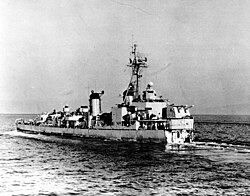USS Ernest G. Small
This article includes a improve this article by introducing more precise citations. (January 2021) ) |
 USS Ernest G. Small underway on 17 November 1950
| |
| History | |
|---|---|
| Name | Ernest G. Small |
| Namesake | Ernest G. Small |
| Builder | Bath Iron Works |
| Laid down | 30 January 1945 |
| Launched | 14 June 1945 |
| Sponsored by | Mrs. E.G. Small |
| Commissioned | 21 August 1945 |
| Reclassified |
|
| Identification |
|
| Decommissioned | 15 November 1970 |
| Stricken | 15 November 1970 |
| Honors and awards | See Awards |
| Fate | Transferred to Republic of China , 13 April 1971 |
| History | |
| Name |
|
| Namesake | Fu Yang |
| Acquired | 13 April 1971 |
| Commissioned | 1 July 1971 |
| Reclassified | DDG-907, 1980s |
| Identification | Hull number: DD-907 |
| Decommissioned | 16 December 1999 |
| Fate | Sunk as target, 8 October 2003 |
| General characteristics | |
| Class and type | Gearing-class destroyer |
| Displacement | 3,460 long tons (3,516 t) full |
| Length | 390 ft 6 in (119.02 m) |
| Beam | 40 ft 10 in (12.45 m) |
| Draft | 14 ft 4 in (4.37 m) |
| Propulsion | Geared turbines, 2 shafts, 60,000 shp (45 MW) |
| Speed | 35 knots (65 km/h; 40 mph) |
| Range | 4,500 nmi (8,300 km) at 20 kn (37 km/h; 23 mph) |
| Complement | 336 |
| Armament |
|
USS Ernest G. Small (DD/DDR-838) was a Gearing-class destroyer of the United States Navy, named for Rear Admiral Ernest G. Small (1888–1944).
Construction and career
Ernest G. Small was
After completing her shakedown cruise in
Following a period of yard availability she reported to Commander, Submarines
Ernest G. Small sailed on 12 June for Norfolk, Virginia, and engaged in type exercises in the Virginia Capes Operating Area. On 6 August she stood out for the Caribbean, calling at Guantanamo and Trinidad before rendezvousing with Task Force 84 (TF 84) which proceeded to Rio de Janeiro where on 7 September the flagship Missouri (BB-63) embarked President Harry S. Truman and his family for the trip to the States. Ernest G. Small steamed on escort station during the voyage.
From 9 February to 10 April 1948 she cruised in the Caribbean and on 7 June began a
Korean War
From January to May 1950 she cruised in the Mediterranean and around northern

Following a brief overhaul at
Ernest G. Small was reclassified DDR-838 on 18 July 1952, and recommissioned on 2 December 1952. She followed training exercises off the California coast with her first peacetime tour of the Far East which lasted from 11 July 1953 through 29 January 1954. Attached to Task Force 77, she was a unit of the blockade and escort force for the Taiwan area.
Operation Wigwam
A period of overhaul ensued and on 10 August 1954 she departed with Destroyer Squadron 13 (DesRon 13) for the
From 1 November 1956 through 28 April 1957 she again toured the
Ernest G. Small began another western Pacific tour in January 1958 as a unit of Destroyer Division 132 (DesDiv 132) and was deployed in various operations, highlighted by participation in the
In March 1959 she was assigned while on her annual Pacific cruise to the operational control of the

Again, she deployed to the
Ernest G. Small was stricken from the
She served in the Republic of China Navy as ROCS Fu Yang (DD-907) on 1 July 1971.
In 1980s, she underwent Wu-Chin I modernization program and reclassified DDG-907.
The ship was decommissioned by Taiwan in December 1999 and sunk as a target on 8 October 2003.
Awards
Ernest G. Small received four
References
This article incorporates text from the public domain Dictionary of American Naval Fighting Ships. The entries can be found here and here.
External links
- Photo gallery of USS Ernest G. Small at NavSource Naval History
